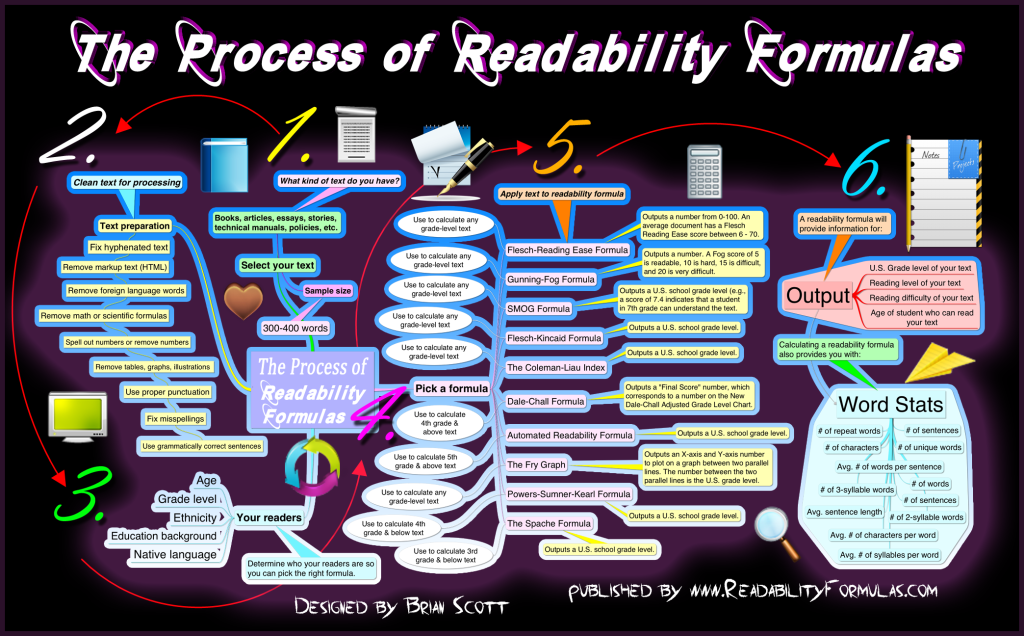In the age of information overload, readers welcome readable text—clear, concise, engaging and easy-to-read words and sentences. Whether your text is a book, article, policy document, or educational material, clarity is important. This is where readability formulas come in—they are tools that score the complexity of your text. Their results can help you self-edit your text to match the reading level of your readers.

Here’s the process of using these formulas:
Step 1: Prepare Your Text
Prepare your text for analysis. Select a sample size of at least 150 words. (Most readability formulas were developed using 100-150 word sample sizes). Your text can be anything: a story; a technical manual; a blog post; instructions; etc. Sanitize the text for processing: remove markup like HTML, extra white space, foreign language words, emojis, mathematical or scientific formulas, etc. Spell out or remove numbers. Eliminate tables, graphs, and illustrations. Most of all, ensure proper punctuation, grammar, and spelling. Readability formulas work best on connected or narrative text: full sentences with correct ending punctuation.
Step 2: Know Your Audience
Understand who will be reading your text. Their age, grade level, ethnicity, educational background, and native language can decide which formula is most useful.
Step 3: Choose the Right Formula(s)
A handful of readability formulas are available, each with a unique focus and output. Here are the most common ones:
- Flesch-Reading Ease: Outputs a number from 0-100. The higher the score, the easier the text is to read. A score between 60 to 70 is considered standard.
- Gunning-Fog: The output represents the grade level needed to understand the text. Scores above 12 indicate texts that are difficult for most people to read.
- SMOG Formula: Simple Measure of Gobbledygook gives a U.S. grade level that readers need to understand the text.
- Flesch-Kincaid: Outputs a U.S. school grade level. It’s widely used in the educational sector.
- The Coleman-Liau Index: provides a U.S. grade level based on sentence length and letter count.
- Dale-Chall Formula: Offers a “Final Score” which correlates with the Dale-Chall Adjusted Grade Level Chart.
- Automated Readability Formula: Outputs a U.S. school grade level.
- The Fry Graph: Provides readability score on a graph which correlates with U.S. grade levels.
- The Spache Formula: Calculates a grade level for texts up to 4th grade.
- FORCAST: Calculates a grade level for advanced/technical non-narrative texts from 6th grade to college .
Step 4: Analyze Readability
Apply the text to your formula. These formulas analyze several aspects of your text, such as syllables per word, average sentence length, sentence complexity, etc. They’ll output a score or grade level that indicates how difficult your text is to understand.
Step 5: Interpret the Results
The final score gives you important information:
- U.S. Grade Level: Indicates the education level someone needs to understand your content.
- Reading Level: Gives a general understanding of how complex your text is.
- Reading Difficulty: A qualitative measure of the text’s complexity.
- Age of Reader: Sometimes, the formulas can estimate the appropriate reader age.
- Word Stats: These include the number of repeat words, characters, sentences, unique words, syllable counts, sentence lengths, hard and easy words, and other metrics.
Compare the readability score or grade level with your audience’s profile. If the text is meant for the general public but requires a postgraduate reading level, you need to simplify it.
Follow these steps to refine your text:
- Simplify sentence structures: break up long, complex sentences into shorter, more manageable ones.
- Replace complex vocabulary with more common synonyms.
- Clarify ideas and concepts.
- Make sentences clearer and more direct with active voice rather than passive voice.
- After making the necessary edits, reapply the formula.
Using this process, score your text with our Readability Scoring System.





